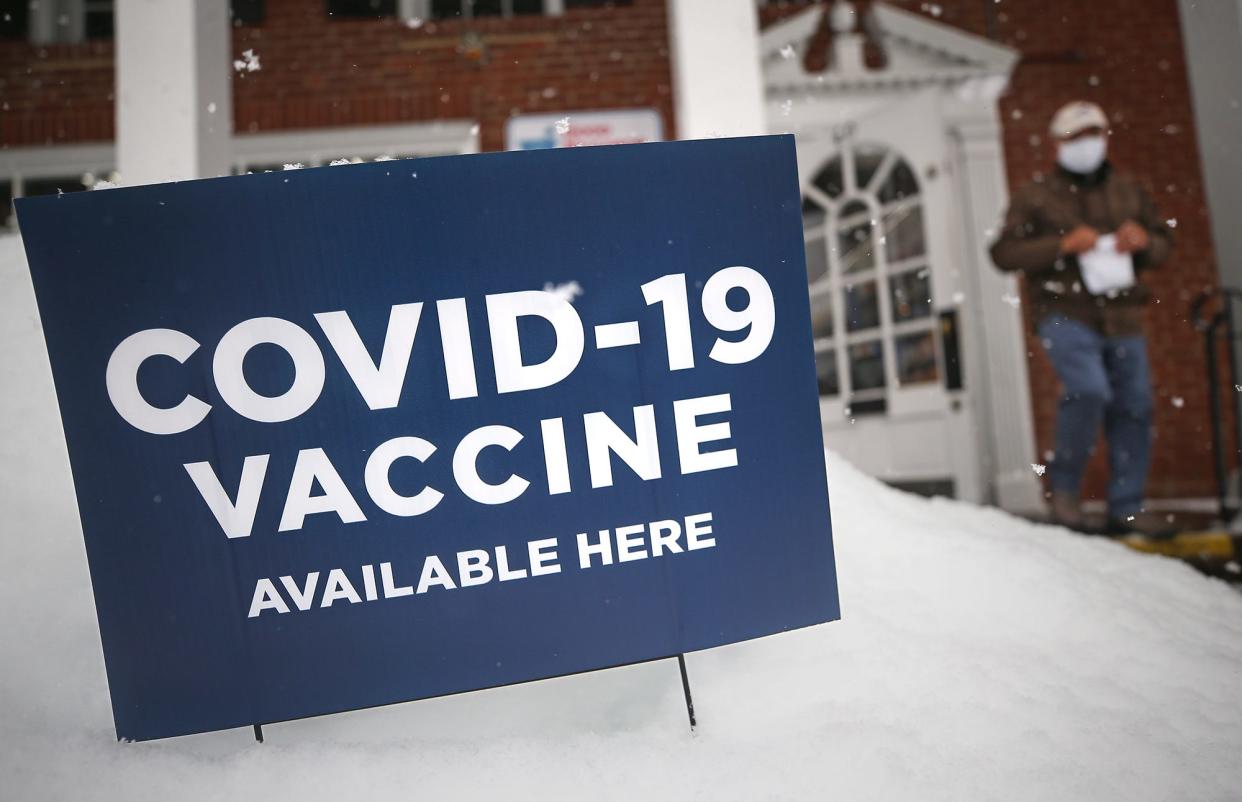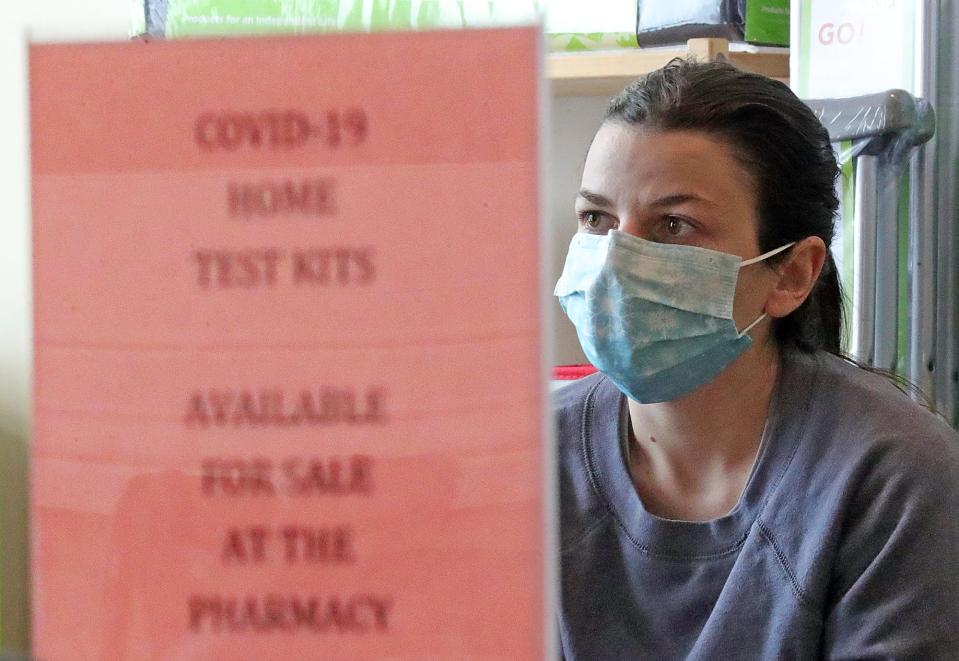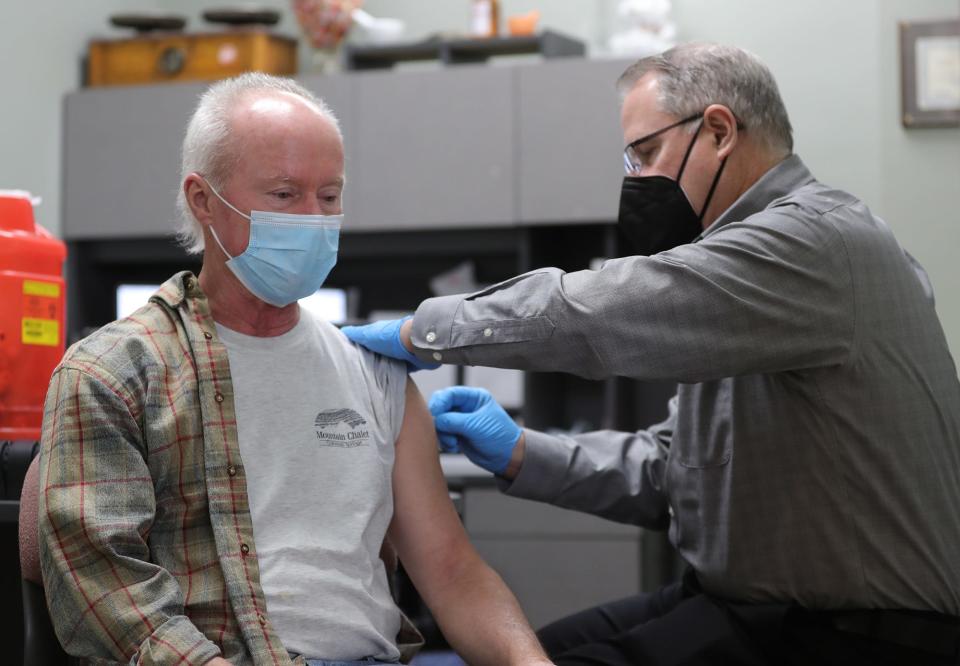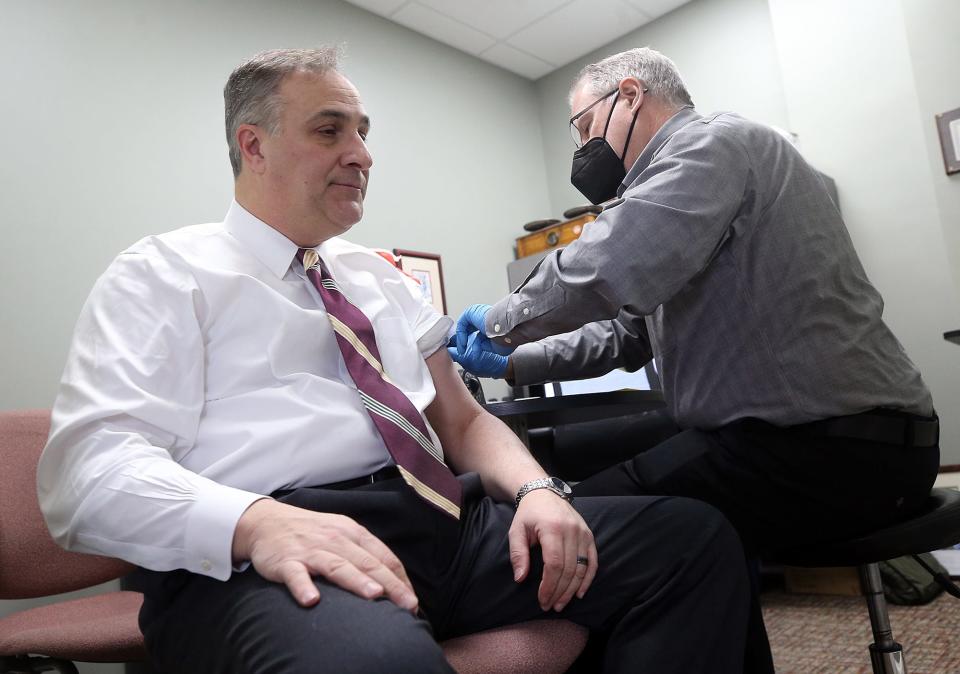65% of Ohio unvaccinated or overdue for COVID booster as omicron surge shifts southward

A nurse of 3½ years, Heather Ciarlariello encountered relatively few COVID patients, at first.
She treated mostly heart and lung transplant patients at Cleveland Clinic’s cardiovascular intensive care unit after earning her bachelor’s degree from the University of Akron. When the pandemic hit, she actually got time off.
Then the respiratory virus reached Ohio. The strictest of no-visitor policies were placed on her susceptible patients, who often require blood oxygenation treatment until their new hearts and lungs could do the job.
“Not only were we their caretakers, we were their family members,” Ciarlariello, 26, said. “We were the only people that they saw 24 hours a day.”
In the past six months, she has watched droves of fellow staff nurses quit due to burnout. She joined them seven weeks ago to become a travel nurse, now pulling three consecutive 12½-hour shifts in a COVID intensive care unit at a hospital in Lima.
She misses the clinic and the critical thinking that came with providing acute care to complex cases. But she’s not working as hard and is earning master’s degree-level wages, she said. But one aspect of her job is markedly more difficult than ever.
“I’ve seen 12 people die in seven weeks, just on my shifts,” she said. “That doesn’t count when I haven’t been there. I can say that didn’t happen at the clinic.”

The Lima hospital in Allen County is now one of the few places in northern Ohio where hospitalizations and deaths continue to spike since the omicron variant arrived in the state in early December. For hard-hit regions like Northeast Ohio, the virus offered no respite from the delta surge raging since August.
'So many patients die': A look inside a COVID unit where beds are full, staff is exhausted
Ciarlariello, who was at Sand Run Pharmacy in Northwest Akron on Thursday getting her booster, said omicron is evading rapid tests. Previous treatments are not as effective, including two monoclonal antibody treatments no longer federally approved for the new variant.
Still, death rates have dropped, suggesting the more contagious omicron is, as early research suggested, less virulent.
While many were overweight or had underlying conditions like asthma, she said 95%-100% of the 12 people she’s recently watch die of COVID were not vaccinated. Health officials continue to push vaccines as the most effective way to avoid severe illness or worse, even as vaccine critics use the increase of breakthrough cases to craft a false narrative that the vaccines are ineffective.
The majority of the COVID-19 patients in our hospitals in December were not vaccinated.
While we are seeing more breakthrough infections, many of them can be handled at home, and not in a hospital.
Get vaccinated, get your booster, social distance and mask up. pic.twitter.com/L8HXPUHkjV— Akron General (@MyAkronGeneral) January 12, 2022
In the past five months, 957,855 Ohioans have completed their vaccinations and another 3,152,653 have been boosted, according immunization data publicly reported by the Ohio Department of Health. That's 4,110,508 people, or 35% of the 11.8 million Ohioans.
That leaves 65% of Ohioans either unvaccinated or overdue for a booster, including the 5.9% of Ohioans under age 5 and still ineligible for a shot.
That's a sharp contrast from what the Ohio Department of Health is reporting: 61% of Ohioans have received at least one shot since December 2020 and 55% are “fully vaccinated,” meaning they've received their initial doses at some point in the past 13 months.
The state agency did not respond to a request for comment last week on what it means to be “fully vaccinated” (considering nearly 3 million Ohioans are overdue for a booster). Many everyday citizens interviewed by the Beacon Journal thought 60%-70% of the state is fully vaccinated. That's a false perception as experts say reaching herd immunity is increasingly a long shot, even with the natural immunity of 1.36 million people infected these past six months.
And now the demand for vaccines is subsiding as hospitalizations and cases drop in the region.
"It kind of dropped off a cliff. Our demand dropped dramatically," said Tom Lamb, who's operated Sand Run Pharmacy since 1989 with his wife, Meg, who is also a pharmacist. "We do have a few days when maybe 50% of our appointments are filled. But it's not 100% like it was — I'd say — two, three, four, five weeks ago."
"We had a backlog of 10-14 days for people to get an appointment. Now, it's pretty much the same day," he said.
But the pandemic is far from over, health experts and public officials warn. There are enough unvaccinated individuals, plus those with waning immunity, to fuel future surges, giving the virus room to mutate into something even more contagious and less manageable.
USA Today: Public health in America at a breaking point. The question is now 'Can it recover?'
“As long as we have virus replication inside the country, we don’t need variants coming in” from places even less vaccinated than the United States, said Angelo DeLucia, an associate professor of molecular virology and cancer biology at Northeast Ohio Medical University. “We can generate variants that can have … immune evasions — by that I mean the ability to circumvent vaccines or immunity that our bodies naturally get after being infected.”
Can COVID infections drive herd immunity?
Ohio has more than doubled its running tally of COVID-19 cases since Aug. 1.
That generated 1.36 million Ohioans with some level of fresh immunity gained through infection. While crippling local hospitals and leaving 11,340 Ohioans dead (and counting), this hard-earned immunity brings the current surge one step closer to ending.
But there's no way of telling exactly how many people are freshly immunized, whether by vaccine or infection. The state separately reports case and immunization data, making it impossible to reconcile the two. For various reasons throughout the pandemic, including inconvenient quarantining from jobs and school, some infected people never get tested or report confirmed infections to county health officials. And some of the 1.36 million recently infected people could be double counted as state and federal health officials consider many positive COVID tests 90 days apart as separate infections in the same person.
Other pathogens have proved that immunity doesn’t last forever. The same common colds are caught each year, health experts note. Influenza cells, for example, can reshape their surface each flu season to be unrecognizable to the body's immune system, said DeLucia, who holds a doctorate in biochemistry and has extensively studied the binding proteins of SARS-CoV-2, which causes COVID-19.
DeLucia said the virus "has burned through every textbook I learned." And scientists like him have not fully mapped all of omicron's mutations, let alone fully understood the implications of its 50 mutations on the genomic sequencing of the cell's RNA, which deliver protein-building instructions from the cell's blueprint DNA.
An average of 13 forecast models recognized by the Centers for Disease Control and Prevention put the end of the current surge at mid-February in Ohio, though some parts have already seen progress while others get worse.
"If the omicron wave follows the same pattern as previous waves, the sharp declines in case rates we are currently seeing will begin to level off over the next few weeks," said Rich Marountas, chief epidemiologist at Summit County Public Health. "Rates will continue to fall more gradually, finally bottoming out in early to midsummer when the outdoor season is in full swing. Because COVID-19 appears to show the same kind of seasonality pattern we see with the flu, look for cases to begin to rise again in late summer – early fall as school resumes and the weather moves us all back inside."
That prediction, Marountas underscored, is dependent on continued caution, masking, robust hygiene and, most important, recapturing ground lost to the slump in vaccinations and boosters.
Conventional wisdom (like those textbooks DeLucia said the virus is rewriting) suggests novel viruses will mildly shift from pandemic to endemic, though when nobody knows.
"If omicron remains the dominant variant, then the combination of repeated exposures and repeated vaccinations (think annual flu shot) should lead to increased immunity for a large number of people," Marountas said. "Unfortunately, the elderly, the very young, as well as immunocompromised people and those with chronic health conditions like obesity or diabetes will remain at greater risk whatever happens."
But it may be premature, experts said, to consider the end of the war with the pandemic in the midst of battling this surge.
Is the COVID surge over?
With daily case totals still hovering around 20,000, Ohio Department of Health Director Dr. Bruce Vanderoff said last week that "we're well premature of saying, 'breathe a sigh of relief.'" But many are asking is this fifth and latest surge over?
The most recent data on cases and hospitalizations suggest that the worst is behind Northeast Ohio. But community spread could remain at what state and local health officials consider dangerous levels for a few more weeks as the surge is only beginning to burn through more remote parts of state.
A few weeks after genomic testing marked its arrival in the United States, the omicron variant was first detected in Central Ohio on Dec. 7. But it took root in Cuyahoga County, quickly spreading in Northeast Ohio and crippling regional hospital systems.
The surge lasted four weeks in Cuyahoga County before case counts began to drop. By Jan. 15, Northeast Ohio had the least cases per capita of any region in Ohio as the surge moved south of Interstate 70 or west of I-77.
Caseloads are still high across Ohio but remain especially elevated in about a dozen of the state’s southernmost counties, from east of Cincinnati to Portsmouth along the Ohio River. These Appalachian counties resemble Cuyahoga County and Northeast Ohio a month ago.
Cases are a leading indicator of the disease’s spread. Wherever cases surge, hospitalizations and deaths are sure to follow.
Vanderoff noted that hospitalizations in Cuyahoga County have dropped 24% in the past week. In Summit County, where the Beacon Journal has collected hospitalization data for the past 14 months, the number of hospitalized patients testing positive for COVID has fallen 46% from 399 on Jan. 6 to 215 on Friday.
Data from the Ohio Hospital Association show hospitalizations for COVID began to fall in the Cleveland area around Jan. 4 then in the Akron region a week later, closely mirroring the local reporting and the southern migration of reported infections.
Vaccine boosters
As a front-line worker quarantining two weeks every time she encountered a COVID patient, Ciarlariello got the vaccine to feel "safer to be around my grandparents and family members who were at-risk, you know, the older population."
She developed hives from the first two shots last year, which made her wait to get the booster. Her doctor recommended Zyrtec, an allergy medicine. She reported no side effects from her third shot.
Ken Dunn, 70, grew up in Cuyahoga Falls. He's spent the last 35 years as a flight attendant for two major airlines while living in Colorado and southern Oregon.
After a year of witnessing the anxiety of passengers and flight personnel coping with inconvenient restrictions, he retired in January 2021.
He got the vaccine as soon as he could in 2020. Again living in Summit County, an asthmatic sibling signed him up for the booster last week, which he gladly received.
"Because this thing is so worldwide, and it's killing people, we should just buckle up and do it," he said, filling out his paperwork to get his third shot at Sand Run Pharmacy on Thursday.
"It blows me away," he said. "Why wouldn't you take a vaccine that's basically free? It's not politics. It shouldn't be."

Controlling for age, education, income, population density and other factors, research by the Beacon Journal, the Pew Research Center and numerous public polls have revealed Republicans to be among the least willing to get the vaccines, with even less approving of vaccine mandates.
Bryan Williams, chair of the Summit County GOP, is not among the 40% of his national party who say they refuse to get the shot.
"In all seriousness, it’s an easy choice," Williams said before rolling up his sleeve for a third dose of Pfizer last week.

“I just think it’s safe. I’m no doctor, but I study how they work," Williams said, concluding that there’s little “chance for side effects — serious side effects, not getting tired or a sore arm.”
But the party boss stands behind personal choice.
"The party is nothing more than a collection of individuals. Both political parties. And so the individuals in both parties can do and say what they choose to do," he said. "The Republican Party in Summit County doesn’t have a position on the vaccines. But I tell everybody I talk to I’ve got [the COVID vaccines] and I recommend they do the same.
He also "doesn't judge anyone for not getting it."
"The other thing," he said, "is I don’t feel they make me vulnerable by their lack of vaccination. Other people disagree with that."
While Williams said he thought 70% of Ohioans are vaccinated (instead of only 35% vaccinated or current on their boosters), "running the economy is more important than everyone’s sense of safety."
What is fully vaccinated for COVID?
Injecting himself into the conversation, Williams' pharmacist, Tom Lamb, asked: "What is fully vaccinated?"
Not even the White House, which was blocked by the Supreme Court last week after trying to mandate vaccine requirements at large private employers, will say.
In his first press conference in 10 months, President Joe Biden last week avoided a direct answer when asked why the White House doesn’t include the booster shot in its definition of fully vaccinated, which would plummet national vaccination rates.
Instead, he advocated for the booster.
The president also said vaccinating every American wouldn’t offer the level of protection needed to end a pandemic that, by definition, is global.
“We can’t pull the wall high enough to keep a new variant out,” he said.
Data and observations about the mutating virus and immunity against it continue to evolve. Throughout the pandemic, scientific revelations have prompted public health officials to update guidance, from how long the virus lives on surfaces (remember the incessant wiping down of groceries and surfaces) to the need for boosters (originally only for at-risk and high-risk populations then for everyone).
The CDC has commissioned studies that suggest immunity from vaccines, like immunity from infections, wanes over time. The agency has even shortened the time between initial doses and boosters.
But the CDC, whose director technically works at the behest of the president, still considers fully vaccinated as having received one shot of the Johnson & Johnson or the initial two-dose regimen of the Pfizer or Moderna vaccine.
Reach reporter Doug Livingston at dlivingston@thebeaconjournal.com or 330-996-3792.
This article originally appeared on Akron Beacon Journal: 65% of Ohio unvaccinated or overdue for COVID booster shot


